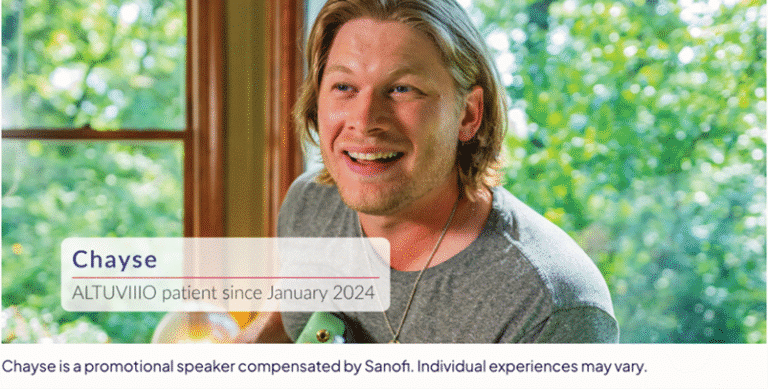What are hemophilia inhibitors, and how might these affect hemophilia treatment?
This is paid educational content from Sanofi and does not constitute an endorsement of products or services. When you click on the links in this blog entry, you will be directed to a Sanofi website. LA Kelley Communications always advises you to be a savvy consumer when contacting any company; do not reveal identifying information against your will.
What are hemophilia inhibitors, and how might these affect hemophilia treatment?
Learn about hemophilia inhibitors, their impact on hemophilia A and B treatments, risk factors, diagnosis, and alternative treatment options for effective care.
If you have hemophilia A or B, you may have heard of the terms—”hemophilia inhibitors,” “factor VIII inhibitors,” or “factor IX inhibitors.” This article explores what hemophilia inhibitors are, why people with hemophilia might develop inhibitors, and what this could mean for your hemophilia treatment.
Hemophilia is caused by a lack of or dysfunction of clotting factors (that is, proteins in the blood that help form blood clots), such as factor VIII or IX, in the body. To counteract this, people with hemophilia are often treated with clotting factor concentrates (CFCs) that temporarily increase clotting factor levels to help prevent or control bleeding episodes. However, hemophilia inhibitors (also known as neutralizing antibodies) can form when a person’s immune system mistakenly identifies these CFCs as something foreign to be attacked. The immune system develops antibodies to these CFCs, stopping them from working effectively.
Who is at risk of developing hemophilia inhibitors?
For people with hemophilia, there are several factors that can increase the risk of developing inhibitors to CFCs. For starters, people with severe hemophilia A are more likely to develop inhibitors than people with hemophilia B. Additionally, genetic, racial, and environmental factors can all contribute to inhibitor development. Let’s explore more about each of these variables!
Rates of inhibitor development in hemophilia A versus hemophilia B
Although inhibitor development is a risk factor for all people taking CFCs, it is far more common in severe hemophilia A than in hemophilia B. Around 25%-40% of people with severe hemophilia A develop inhibitors, whereas only 1%-5% of people with hemophilia B develop inhibitors. Inhibitor development is less prevalent in people with moderate/mild hemophilia A, with <5%-15% developing inhibitors. As a final note, people with severe hemophilia A and B are both more likely to develop inhibitors early in their treatment life cycles. In hemophilia A, 79% of those who developed inhibitors did so in their first 20 exposures. In hemophilia B, most inhibitor development occurred after a median of 9 to 11 exposures.
Genetic risk factors for hemophilia inhibitors
People with specific types of genetic mutations are more likely to develop inhibitors. A family history of inhibitors in those with hemophilia could raise the risk of developing inhibitors.
People from certain ethnic backgrounds, such as Black or Hispanic/Latinx, may be more likely to develop inhibitors.
Environmental risk factors for hemophilia inhibitors
Along with genetic risk factors, there are also environmental risk factors—certain things related to a person’s lifestyle and environment—that can affect the risk of developing inhibitors. For example, using large amounts of factor replacement or being treated more often, especially during early childhood, might increase the chance of developing inhibitors due to greater exposure.
Other environmental factors, such as surgery, inflammation, and infections, can also increase the likelihood of developing inhibitors.
How do I know if I have developed hemophilia inhibitors?
Inhibitors may be discovered during routine inhibitor screening or when a person with
hemophilia does not respond to factor treatment. Blood tests are used to detect inhibitors
and their levels; this level is known as an inhibitor titer. A person with a high inhibitor titer
has more inhibitors present in the blood compared to someone with a low inhibitor titer.
Those diagnosed with low titer inhibitors are often closely monitored as a first step,
depending on the situation. For people with hemophilia who have high levels of inhibitors in
their blood, immediate changes may be needed to treat and prevent bleeds. Doctors may
need to use different treatments to manage their condition effectively.
How do hemophilia inhibitors impact my treatment options?
Inhibitors can make hemophilia treatments, like CFCs, work less effectively or sometimes
not work at all. This can lead to more frequent bleeding episodes. If inhibitors are detected,
it’s important to create a management plan as soon as possible to make sure you get the
best care. This is most effective when done at a hemophilia treatment center that has
experience treating people with inhibitors. Treatment for hemophilia patients with
inhibitors includes bypassing agents and nonfactor therapies.
Bypassing agents
Bypassing agents are used to treat bleeding episodes in people with high levels of inhibitors
in the blood. Instead of replacing the missing factor, they go around (or bypass) the factors
that are blocked by the inhibitor to help the body form a normal clot.
Non-factor therapies
Non-factor agents are treatments that help promote blood clotting without having to
replace missing clotting factors with CFCs. These agents work by either boosting your
body’s natural ability to clot or improving how well existing clotting factors work together.
Deciding on the best option for you if you develop hemophilia inhibitors
All people with hemophilia who are treated with CFCs are at risk of developing inhibitors. If
you develop inhibitors during your hemophilia treatment, it’s important to discuss all
available options with your healthcare provider, as this will help tailor the most effective
approach for your specific needs.










